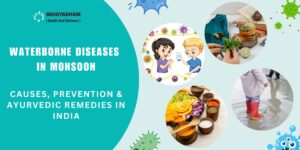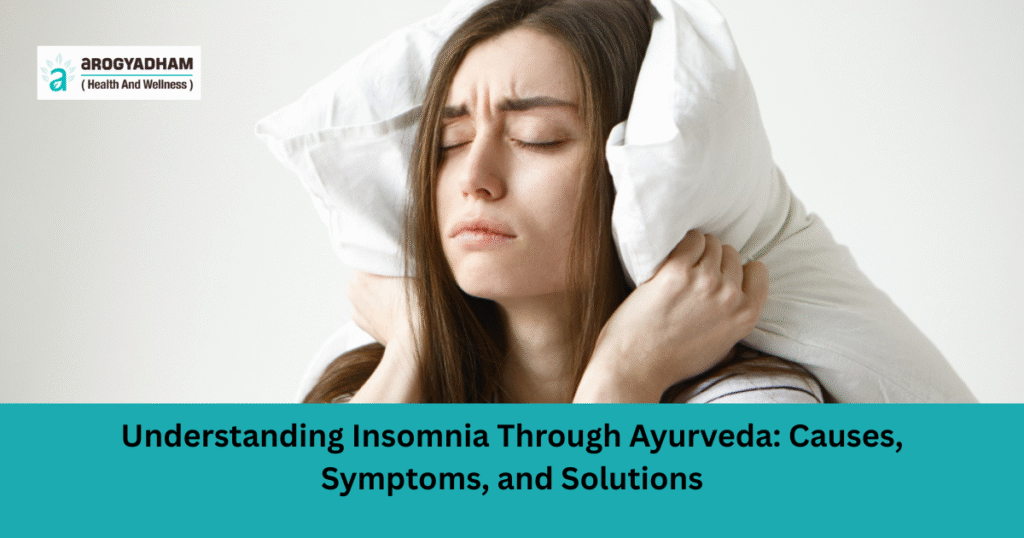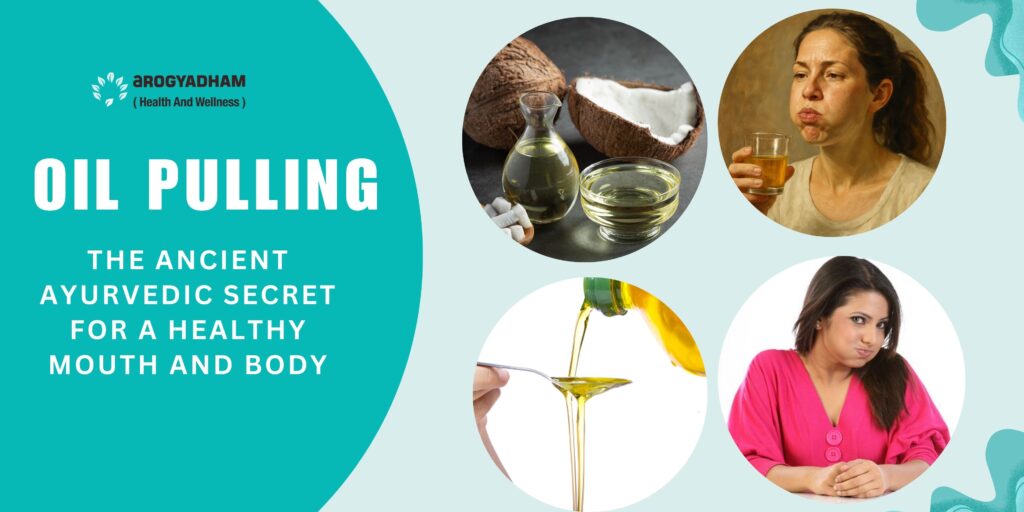Waterborne Diseases in Monsoon: Causes, Prevention & Ayurvedic Remedies in India
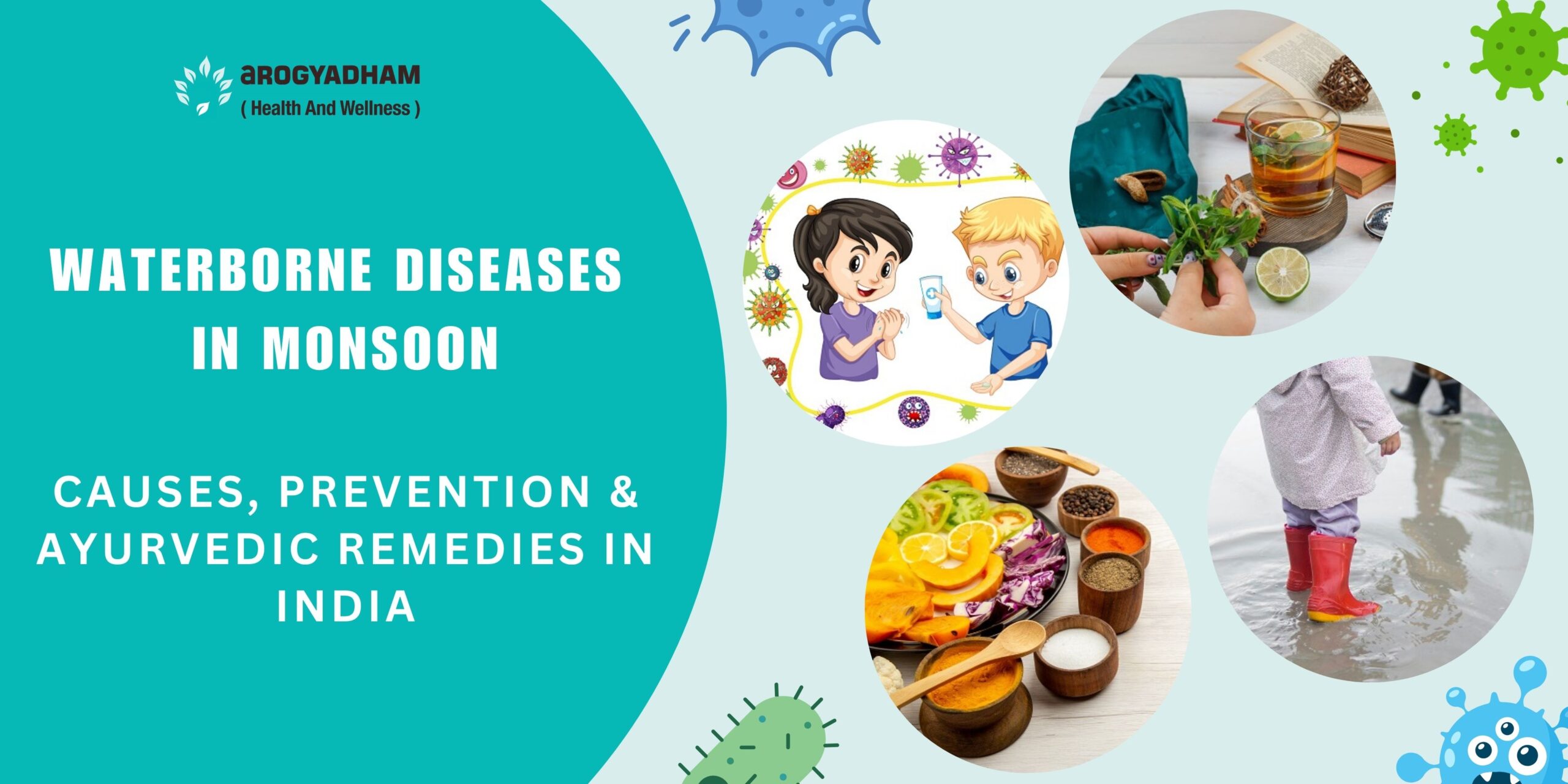
The Indian monsoon is a welcome break from the harsh summer, bringing greenery, cooler temperatures, and fresh air. But it also brings a serious rise in seasonal health issues. One of the most serious illnesses is the rise of waterborne diseases. The constant rains, waterlogging, and poor sanitation create ideal conditions for these infections to thrive, especially in urban and semi-urban areas.
It is important to know how waterborne diseases are transmitted and how to protect yourself and your family during the rainy season. In this guide, we will define waterborne diseases, their causes, symptoms, and preventative measures, and define the comprehensive approach of Ayurveda to tackle waterborne diseases, particularly during monsoon.
What are Waterborne Diseases?
Waterborne diseases are infections caused by drinking or coming into contact with water that’s contaminated with bacteria, viruses, or parasites. These diseases are usually spread through:
- Drinking Unclean Water
- Eating Contaminated Food
- Contact with Infected Human or Animal Waste
- Poor Hygiene and Sanitation Practices
In India, monsoons usually cause overflowing drains, stagnant water, and poor drainage systems, which contribute to waterborne diseases.
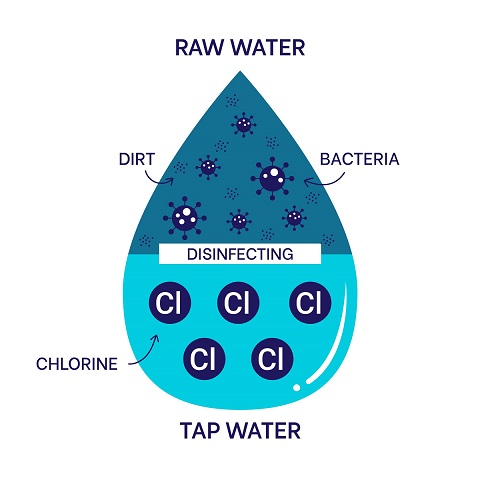
Common Waterborne Diseases in India During Monsoon
Health centres in India see an annual increase in the following infectious waterborne diseases every monsoon:
Cholera
Cholera is an infectious disease caused by the bacteria Vibrio cholerae, and it causes abrupt, watery diarrhoea and dehydration. Once cholera settles into an area, it spreads rapidly through infected water or food.
Typhoid
Typhoid fever is a serious bacterial infection that may lead to high temperature, severe diarrhoea, abdominal pain, or constipation. Typhoid enters the human body through contaminated food and/or water.
Hepatitis A and E
Hepatitis A and E are viral infections that affect the liver. Symptoms of hepatitis A and E include jaundice, loss of appetite, dark urine, and fatigue. Their viruses are enteropathogenic, infecting humans through water that is contaminated via the human faecal-to-water route.
Diarrhoea
Diarrhoea is by far the most common waterborne disease experienced in the monsoon. Germs cause diarrhoea, leading to loose stools, abdominal pain, dehydration, and irritability.
Gastroenteritis
Gastroenteritis affects the stomach and intestines. Symptoms of gastroenteritis include nausea, vomiting, watery stools, and abdominal cramps. Gastroenteritis can also be from the bacteria found in unsafe retail food and water.
Giardiasis
Giardiasis is caused by the parasitic protozoan Giardia lamblia, which causes severe stomach cramps, bloating, and diarrhoea. Giardiasis may be especially common where potable drinking water may be scarce.
Dysentery
Dysentery, more specifically amoebic dysentery, is an infectious disease expressed via severe diarrhoea, mucus, and sometimes blood. It spreads through contaminated food and water or poor hygiene.
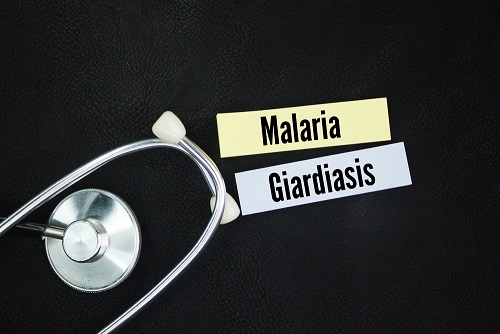
These illnesses not only cause discomfort but can lead to serious complications if not treated promptly.
Why Monsoon Brings Waterborne Illnesses in India
The reasons for the seasonal rise in waterborne diseases during monsoons are simple, but they come from growing issues around infrastructure and environment, like:
- Stagnant Water: Bodies of standing water, regardless of size, become breeding grounds for potentially harmful microorganisms.
- Contaminated Drinking Water: During flooding, the source of the water supply becomes combined with sewage.
- Open Defecation and Ineffective Waste Disposal Practices: These act as additional contaminants of water bodies and soil.
- Street Food Culture: Some monsoon street food may be made using bad water or stored in unsanitary conditions.
These are some of the problems that combine to make waterborne illness a problem without any easy interventions, especially in areas where sanitation is less than satisfactory.
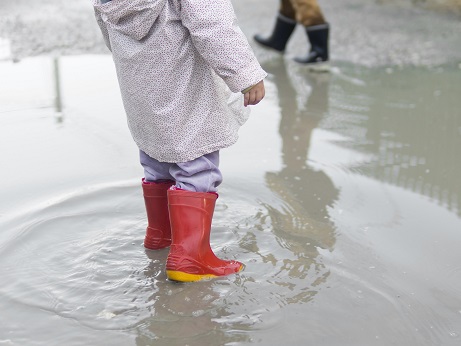
Look for These Symptoms
Identifying the early stages of the illness can prevent the illness from progressing to a more severe disease. Some common signs are:
- Frequent watery or loose stools
- Fever (high) with chills
- Abdominal cramps and/or pain
- Vomiting and nausea
- Dehydration (dry mouth, dizziness, less urination, and left dysfunction).
- Jaundice (yellowing of eyes or skin) in hepatitis
If any of these symptoms endure for more than a day or get worse quickly, please seek medical or Ayurvedic help.
Who Is Most at Risk During Monsoon?
Waterborne illness can occur with anyone, and certain groups are at even higher risk:
- Children in the under-five age group
- Elderly individuals, especially those who are also immunocompromised
- Pregnant women
- Individuals with Poor Digestion
- Those who are already living with Chronic Medical Conditions
This represents just a sampling of unique groups, and extra attention should be paid to all individuals in these groups to avoid complications or hospitalisation.
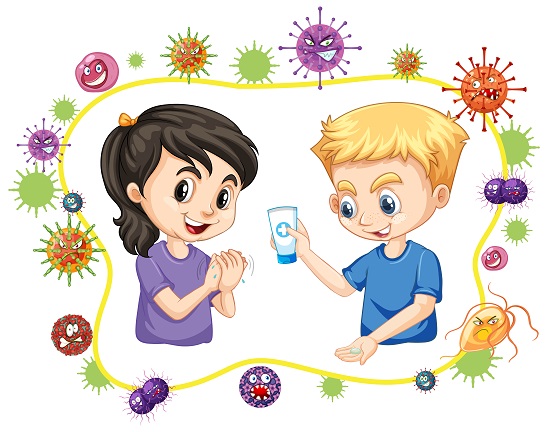
How Ayurveda Understands Waterborne Disease
Ayurveda believes that our internal water or fluid (rasa dhatu) is made from and comes from digestion, and therefore all waterborne illnesses arise from disturbed digestion in the gut, bad digestion that leads to Ama (toxicity) formation if not treated, and Pitta dosha imbalance (the dosha connected to digestion and metabolism).
Classical Ayurvedic texts describe how contaminated food and water may disturb agni, or digestive fire, leading to undigested waste and ama to circulate in the system. The weakness permits entry for pathogens.
The goal of Ayurveda is not just to mitigate symptoms, but to:
- Restore digestive strength
- Detoxify the body
- Inoculate for immunity (Ojas)
Ayurvedic Solutions for Waterborne Diseases
The healing tools that nature offers are extremely powerful guides. There are Ayurvedic herbs and treatments available that might help manage and/or prevent waterborne disease:
1. Kutaj (Holarrhena antidysenterica)
Very effective for the management of diarrhoea and dysentery. Kutaj bark powder or decoction can assist with controlling intestinal infections and improving digestion.
2. Bilva (Bael Fruit)
Used historically to treat, specifically, gastrointestinal disorders, bilva pulp can help to soothe the gut and manage loose stools.
3. Musta (Nut Grass)
Ultimately, a great herb for the management of fever and vomiting. Musta improves digestion and decreases the build-up of toxins.
4. Pippali (Long Pepper) & Haritaki
To strengthen the digestive fire and remove Ama. Both can enhance digestion and absorption and fight microbial infection.
5. Ayurvedic Decoctions (Kwathas)
It is not unusual for an Arogyadham practitioner to make an herbal decoction (kwatha) personalised to the patients’ condition.
6. Panchakarma Detox (If Required)
In the event of a chronic and/or recurrent presentation, Ayurvedic detox therapies such as Virechana (purgation) or Basti (enema) may be suggested to purge your gut of unwanted toxins and rebalance your doshas.

Preventive Tips for Waterborne Diseases During Monsoon
The best option against the risks of waterborne diseases is to avoid them and also bolster your “internal-baodhan” immunity. Keep this list of daily preventative habits with you:
- Drink only boiled/filtered or RO water
- Avoid ice made from unknown sources
- Do not eat uncooked food or street snacks during the monsoon
- Always wash fruits and vegetables thoroughly
- Store drinking water in clean, covered containers
- Wash hands before meals and after toilet use
- Disinfect water tanks and pipes regularly
Ayurvedic Diet Tips for Monsoon Season
The monsoon influences digestion, and thus it is essential to consume foods that are easily digestible, which may also promote gut health by one of the 3 doshas in the digestive process.
- Opt for light, warm, cooked meals such as khichdi, moong dal soup, or steamed vegetables.
- Avoid cold, raw, fried, and/or oily foods.
- Drink herbal teas containing ginger, tulsi, or fennel.
- Cook with dry ginger, cumin, and coriander to help support digestion.
- Do not skip meals, and eat at the same time each day—eating at the same time each day helps maintain the digestive rhythm.
- Eating a clean or sattvic diet assists in balancing Agni and suppressing Ama formation.
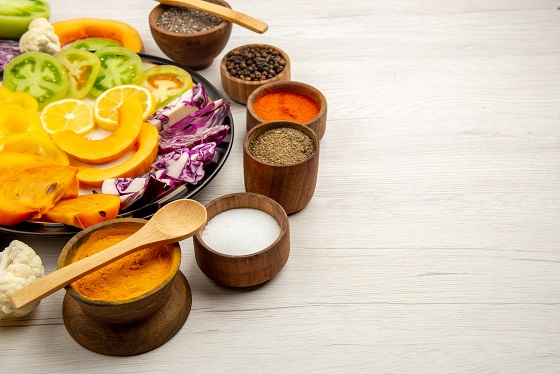
When to Seek Medical or Ayurvedic Care
You should never ignore symptoms that last for longer than a day, especially if they are severe and concern vulnerable family members.
See a doctor if:
- You or your child becomes dehydrated
- Fever or diarrhoea continues for longer than 24–48 hours
- You see blood in stools or vomit
- You feel persistently weak, tired, or jaundiced
At Arogyadham Health, our Ayurvedic specialists can provide you with:
- Detailed assessment of your condition
- Personalised treatment plans
- Herbal remedies with no side effects
- Detoxification therapies, if necessary
- Dietary and lifestyle changes assist in long-lasting recovery.
Arogyadham Health’s Role in Monsoon Wellness
At Arogyadham Health & Wellness, we are aware of the impact that monsoon has on your body. Our Ayurvedic doctors are trained to manage waterborne diseases holistically and naturally without the use of harmful chemicals and antibiotics. Our focus will include:
- Resolving the issue at its root cause, instead of masking the symptoms
- Restoring the balance of your doshas through personalized care
- Increasing your immunity by using herbs and Ayurvedic tonics
- Completely detoxifying the body so that the disease does not recur
- Directing your diet and lifestyle choices in a way that allows your gut/process to be nourished for longevity
Fundamentally, we focus on providing a safe, holistic healing experience that aligns with nature and your body’s own natural tempo.
Conclusion
The monsoon season does inspire a freshness and beauty this time of year, but it may also hide some serious health risks. Every year in India, waterborne diseases continue to affect millions, but negligible awareness and precautions allow for poor preparedness. The genius of Ayurveda not only allows you a very powerful, yet gentle and natural way to treat, but also prevent these diseases through improving digestion, detoxifying the body, and building immunity.
So let’s make this season one of health, harmony, and healing from nature. If you or your loved ones experience any signs or symptoms of waterborne diseases, trust the ancient science of Ayurveda and consult the professionals at Arogyadham Health for long-term well-being.
FAQs on Waterborne Diseases During Monsoon in India
Q1. What are the common waterborne diseases during the monsoon in India?
Ans: The commonly occurring waterborne diseases during the monsoon are Cholera, Typhoid fever, Hepatitis A and E, Diarrhoea, and gastroenteritis.
Q2. How do waterborne diseases spread during the rainy season?
Ans: Waterborne diseases are spread by consuming contaminated drinking water, poor sanitation, and unsafe food consumption.
Q3. How can I prevent my family from waterborne diseases during the rainy season?
Ans: Make sure you boil and filter the water, maintain good hygiene, and avoid street food.
Q4. What are the symptoms of waterborne infections?
Ans: Symptoms include diarrhoea, vomiting, fever, stomach pain, and dehydration.
Q5. Are children more susceptible to waterborne diseases?
Ans: Yes, children under the age of 5 are at a higher risk as they have weaker immunity to common stomach infections.
Q6. Can Ayurveda treat waterborne diseases?
Ans: Yes, Ayurveda has various herbal remedies and detox therapies for natural treatment.
Q7. What Ayurvedic medicinal herbs are used to treat waterborne illnesses?
Ans: The common herbs used to treat waterborne illnesses are Kutaj, Bilva, Musta, Haritaki, and Pippali.
Q8. Is diarrhoea always a result of a waterborne infection during the rainy season?
Ans: Not necessarily, but it is likely to be caused by contaminated food or water.
Q9. Are waterborne illnesses serious, and how long can they last?
Ans: Mild cases last within 2-3 days, but extreme cases generally require medical assistance or Ayurvedic care.
Ready to Heal Naturally?

Share With
Friends

Dr. Rakesh Agarwal, a third-generation Ayurveda expert and research scholar, treats chronic ailments through Ayurveda and Panchakarma. He is also the founder-editor of Arogyadham Magazine, promoting Ayurveda and wellness to over a million readers since 1992.

Dr. Arjun Raj, an Ayurvedic physician and wellness expert, is the Director of Arogyadham Health Care and serves on the executive board of Arogyadham Health and Wellness. He blends traditional Ayurveda with modern wellness to promote balanced, healthy living.

Dr. Amrit Raj, an Ayurvedic doctor and certified yoga teacher, is the Director of Arogyadham Health and Wellness. He specializes in chronic conditions and actively promotes Ayurveda and yoga worldwide for healthier living.




